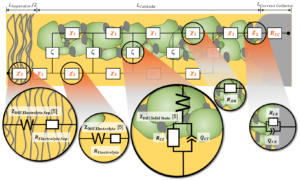Summary:
Simulation models predicting the cell voltage of lithium-ion-batteries are used in different areas like e.g. battery management systems (BMS) or future cell development. For BMS often equivalent circuit models (ECM) are applied. ECM are characterized by short calculation times, but do not contain physical parameters. For cell development usually, more complex physical models are used. Physical models contain a lot of parameters which can be varied easily but usually have long computation times. The goal of this work is the development of a compact simulation model combining the benefits of having both well-chosen physical parameters and short computation times with the aim to calculate the cell voltage of lithium-ion-batteries.
The cell voltage is calculated by subtracting the overvoltage, described by the cell impedance Z multiplied with the electrical current I, from the open circuit voltage (OCV). The cell impedance is derived from the electrode impedance of the anode and cathode as well as the separator impedance.
The electrode impedance is modeled using a transmission line model (TLM) consisting of an electronic, a coupling, and an ionic path. The electronic path consists of a resistance describing the electronic conductivity of the active material. The coupling path covers the solid-state diffusion as well as the charge transfer process. The ionic path considers both the ionic resistance as well as the electrolyte diffusion. The separator impedance covers both an ionic resistance as well as the electrolyte diffusion.
The model is parameterized via electrochemical impedance spectroscopy (EIS) and microstructure analysis. Further data like e.g. ionic conductivities and diffusion constants are extracted from literature.
The modeled voltage curves are in good agreement with the measured voltage curves for the charging process. However, deviations arise for the discharge process for higher discharge currents. This effect is mainly caused by electrolyte depletion over the thickness of the electrode. To cover these deviations the model will be extended with an electrolyte concentration dependency in the near future.
We are happy to forward your request / feedback.

